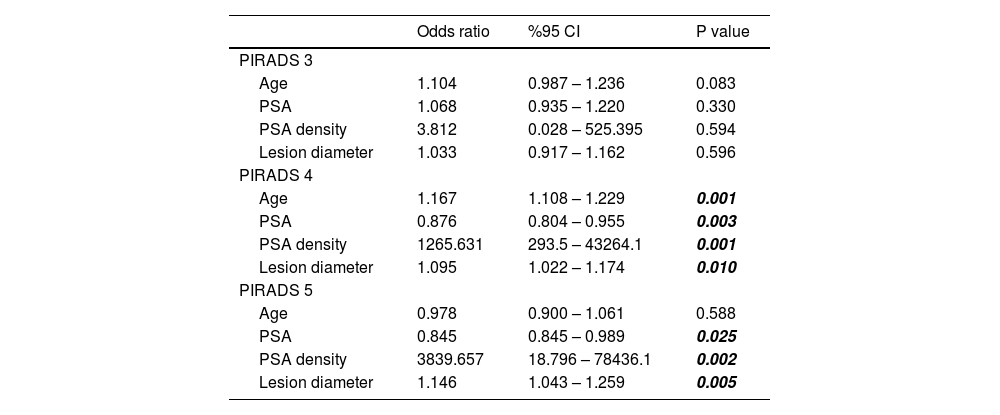Prostate cancer (PCa) ranks second among prevalent cancers in men, necessitating effective screening tools such as multiparametric magnetic resonance imaging (mpMRI) with the prostate imaging reporting and data system (PI-RADS) classification. This study explores the impact of lesion volume on clinically significant prostate cancer (csPCa) detection rates in PI-RADS 3–5 lesions, aiming to contribute insights into the underexplored relationship between lesion size and csPCa detection.
Materials and methodsA retrospective analysis was conducted on data from 754 patients undergoing mpMRI-guided transrectal ultrasound (TRUS) prostate biopsy between January 2016 and 2023. Patients with PI-RADS 3, 4, and 5 lesions were included. Lesion size and PI-RADS categories were assessed through mpMRI, followed by MR fusion biopsy.
ResultsOf the patients, 33.7%, 52.3%, and 14.1% had PI-RADS 3, 4, and 5 lesions, respectively. Lesion sizes correlated significantly with csPCa detection in PI-RADS 4 and 5 categories. For PI-RADS 3 lesions, no significant differences in csPCa rates were observed based on lesion size. However, in PI-RADS 4 and 5 groups, larger lesions showed higher csPCa rates.
ConclusionThis study suggests that subgroup categorizations based on lesion volume could predict clinically significant PCa with high accuracy, potentially reducing unnecessary biopsies and associated overtreatment. Future research should further explore the relationship between lesion size and csPCa, clarifying discussions regarding the inclusion of systematic biopsies in diagnostic protocols.
El cáncer de próstata (CP) ocupa el segundo lugar entre los cánceres prevalentes en la población masculina, por lo que se requieren herramientas de cribado eficaces como la resonancia magnética multiparamétrica (RMmp) junto con la clasificación PI-RADS (Sistema de procesamiento de datos y generación de reportes para imágenes de la próstata). El presente estudio pretende evaluar el impacto del volumen de la lesión sobre las tasas de detección del cáncer de próstata clínicamente significativo (CPcs) en lesiones con una puntuación PI-RADS de entre 3 y 5, y profundizar sobre la inexplorada relación entre el tamaño de la lesión y la detección del CPcs.
Materiales y métodosSe realizó un análisis retrospectivo de los datos de 754 pacientes sometidos a biopsia de próstata guiada por ecografía transrectal (ETR) y resonancia magnética multiparamétrica (RMmp) entre enero de 2016 y 2023. Se incluyeron pacientes con lesiones PI-RADS 3, 4 y 5. El tamaño y la categoría PI-RADS de las lesiones se evaluaron mediante RMmp, seguida de biopsia por fusión de RM.
ResultadosEl 33,7%, 52,3% y 14,1% de los pacientes tenían lesiones PI-RADS 3, 4 y 5, respectivamente. El tamaño de las lesiones se correlacionó significativamente con la detección de CPcs en las categorías PI-RADS 4 y 5. Para las lesiones PI-RADS 3, no se observaron diferencias significativas en las tasas de CPcs según el tamaño de la lesión. Sin embargo, en los grupos PI-RADS 4 y 5, las lesiones de mayor tamaño mostraron tasas de CPcs más elevadas.
ConclusionesEl presente estudio sugiere que la categorización por subgrupos basada en el volumen de la lesión podría predecir el CP clínicamente significativo con mayor precisión, reduciendo potencialmente las biopsias innecesarias y el sobretratamiento. Futuras investigaciones deberían explorar más a fondo la relación entre el tamaño de la lesión y el CPcs para arrojar luz sobre el debate de la inclusión de las biopsias sistemáticas en los protocolos diagnósticos.










